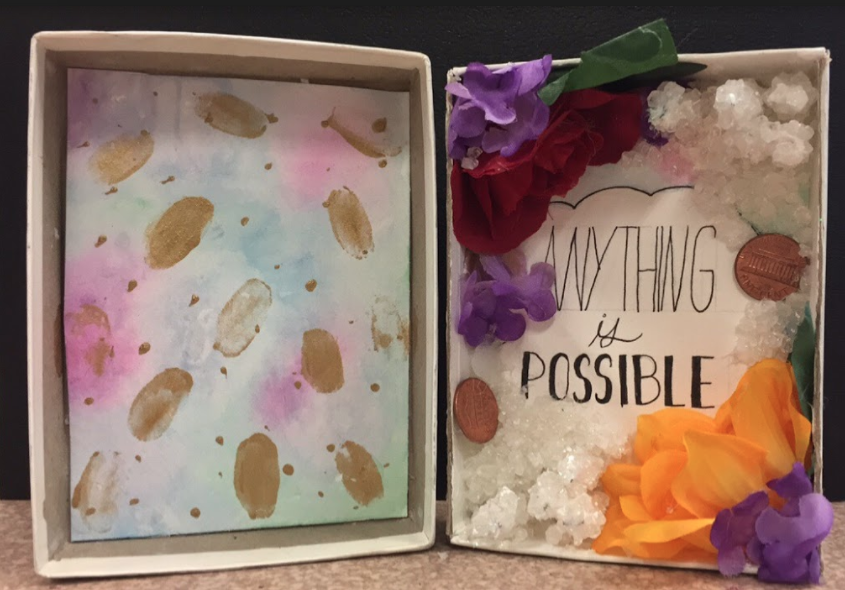Video How Art Helped a Struggling Student Better Understand Himself
For case, students may create "mood mandalas" by drawing and coloring symbols to convey their inner worlds. They can also paint their worries on small "comfort" boxes and fill the container with personal items that bring solace. Others list their insecurities in "identify book" journals, including healing words, like "Larn to accept your flaws and learn to accept beauty." All group members receive "identify books" where they privately record their thoughts and feelings.

During each gathering, Wardrip shares phrases like, "Retrieve, you don't experience improve by feeling less" and "Your thoughts are always valid." Using these prompts, she invites students to begin a discussion. Although they're not required to participate, most of them practice. For many students, being surrounded by a community of nonjudgmental listeners helps them open upward, and kids who once felt afraid brainstorm to feel brave, co-ordinate to Wardrip.
Mental Wellness is Personal
Mental disease is a topic Wardrip knows intimately. For well-nigh a decade, she silently battled depression, hiding her psychological pain from family and friends.
"My depression never fabricated sense to me," she says. "I didn't understand why I felt hopeless when I had a skillful life. I stayed quiet because I didn't desire people to remember less of me."
It wasn't until Wardrip began a graduate school program, Creative Pulse at the Academy of Montana, that she began to heal from her low. Artistic Pulse is a principal'southward plan, pedagogy educators how to integrate art, creativity, move and mindfulness into the classroom.
"In my programme, I was challenged to do the nearly of import affair I could do for myself, which helped me open upward about my depression and suicidal tendencies. I firmly believe the plan saved my life," says Wardrip.
During her graduate studies, she relied on art and mindfulness to help her access and limited emotions she had kept bottled up for years. Eventually, Wardrip opened upwards to close family and friends. Her journey taught her that shame often prevents people from seeking psychological care.
Unfortunately, Wardrip'south experience is not unusual. Although depression and anxiety are the virtually common mental health concerns, surveys have found that lxxx per centum of adolescents with a diagnosable anxiety disorder and 60 percent of depressed kids do not receive treatment. In fact, a recent survey conducted past Kaiser Permanente institute 55 percent of people view depression every bit a personal weakness, and 24 per centum of millennials believe most people tin recover without professional services, like psychotherapy.*
"I realize how stigma is silencing, especially for adolescents. I desire to be a role model for our students, which is why I began Artistic Courage," says Wardrip.
Many of the kids in Wardrip'southward 10-week group struggle with depression, anxiety and gender dysphoria. Others experience alone and out of place. All of these students are searching for someone who can empathise their suffering.
To assist create a safe space, Wardrip begins each meeting with a wellness check-in, followed by a guided meditation and an fine art-related activity. Her group combines creative procedure with psychological theory.
Art Equity
According to the American Fine art Therapy Clan, artistic expression may subtract anxiety, feelings of anger and low. This creative process can as well enhance cognitive abilities, foster greater cocky-awareness and help students regulate their emotions.
Despite these findings, in that location's an equity gap in arts education. A survey conducted in 2012 by the Department of Didactics discovered students in low-poverty schools were more likely to receive fine art instruction than kids attending high-poverty schools. While proposed federal cuts could eliminate art education in many schools, teachers like Wardrip advocate for art inclusion.
"Art teaches kids trouble-solving and controlling skills," says Wardrip. "Creativity too promotes identity development, helping students find their 'place' in the earth."
Wardrip finds that past the finish of the 10-calendar week course, students begin to heal. Her data from terminal year's group suggest participants' symptoms of feet and depression lessened by 40 per centum. To measure this change, each grouping member completed an anxiety and depression questionnaire: ane before the group began, and another afterwards completing the form.
For many of these kids, fine art becomes a tool, helping them to share their accurate selves in a community that understands.
Juli Fraga is a psychologist and writer in San Francisco. Y'all tin can find her on Twitter @dr_fraga
*This post has been updated to more accurately reflect the results of the survey.
dingleraccamented.blogspot.com
Source: https://www.kqed.org/mindshift/49569/how-making-art-helps-teens-better-understand-their-mental-health
0 Response to "Video How Art Helped a Struggling Student Better Understand Himself"
Post a Comment